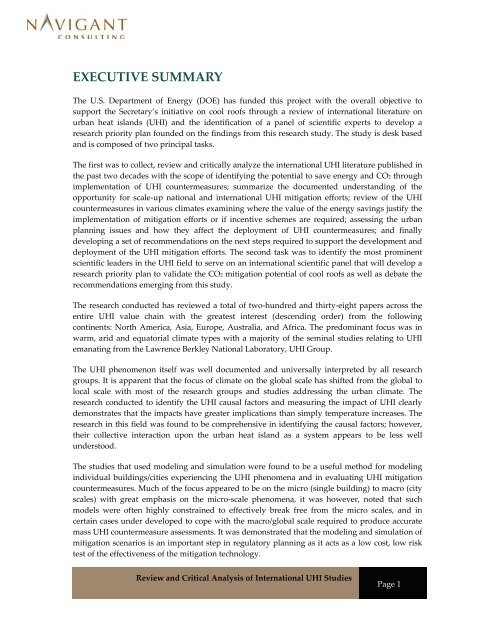Review and Critical Analysis of International UHI Studies
Review and Critical Analysis of International UHI Studies
Review and Critical Analysis of International UHI Studies
Create successful ePaper yourself
Turn your PDF publications into a flip-book with our unique Google optimized e-Paper software.
EXECUTIVE SUMMARY<br />
The U.S. Department <strong>of</strong> Energy (DOE) has funded this project with the overall objective to<br />
support the Secretary’s initiative on cool ro<strong>of</strong>s through a review <strong>of</strong> international literature on<br />
urban heat isl<strong>and</strong>s (<strong>UHI</strong>) <strong>and</strong> the identification <strong>of</strong> a panel <strong>of</strong> scientific experts to develop a<br />
research priority plan founded on the findings from this research study. The study is desk based<br />
<strong>and</strong> is composed <strong>of</strong> two principal tasks.<br />
The first was to collect, review <strong>and</strong> critically analyze the international <strong>UHI</strong> literature published in<br />
the past two decades with the scope <strong>of</strong> identifying the potential to save energy <strong>and</strong> CO2 through<br />
implementation <strong>of</strong> <strong>UHI</strong> countermeasures; summarize the documented underst<strong>and</strong>ing <strong>of</strong> the<br />
opportunity for scale‐up national <strong>and</strong> international <strong>UHI</strong> mitigation efforts; review <strong>of</strong> the <strong>UHI</strong><br />
countermeasures in various climates examining where the value <strong>of</strong> the energy savings justify the<br />
implementation <strong>of</strong> mitigation efforts or if incentive schemes are required; assessing the urban<br />
planning issues <strong>and</strong> how they affect the deployment <strong>of</strong> <strong>UHI</strong> countermeasures; <strong>and</strong> finally<br />
developing a set <strong>of</strong> recommendations on the next steps required to support the development <strong>and</strong><br />
deployment <strong>of</strong> the <strong>UHI</strong> mitigation efforts. The second task was to identify the most prominent<br />
scientific leaders in the <strong>UHI</strong> field to serve on an international scientific panel that will develop a<br />
research priority plan to validate the CO2 mitigation potential <strong>of</strong> cool ro<strong>of</strong>s as well as debate the<br />
recommendations emerging from this study.<br />
The research conducted has reviewed a total <strong>of</strong> two‐hundred <strong>and</strong> thirty‐eight papers across the<br />
entire <strong>UHI</strong> value chain with the greatest interest (descending order) from the following<br />
continents: North America, Asia, Europe, Australia, <strong>and</strong> Africa. The predominant focus was in<br />
warm, arid <strong>and</strong> equatorial climate types with a majority <strong>of</strong> the seminal studies relating to <strong>UHI</strong><br />
emanating from the Lawrence Berkley National Laboratory, <strong>UHI</strong> Group.<br />
The <strong>UHI</strong> phenomenon itself was well documented <strong>and</strong> universally interpreted by all research<br />
groups. It is apparent that the focus <strong>of</strong> climate on the global scale has shifted from the global to<br />
local scale with most <strong>of</strong> the research groups <strong>and</strong> studies addressing the urban climate. The<br />
research conducted to identify the <strong>UHI</strong> causal factors <strong>and</strong> measuring the impact <strong>of</strong> <strong>UHI</strong> clearly<br />
demonstrates that the impacts have greater implications than simply temperature increases. The<br />
research in this field was found to be comprehensive in identifying the causal factors; however,<br />
their collective interaction upon the urban heat isl<strong>and</strong> as a system appears to be less well<br />
understood.<br />
The studies that used modeling <strong>and</strong> simulation were found to be a useful method for modeling<br />
individual buildings/cities experiencing the <strong>UHI</strong> phenomena <strong>and</strong> in evaluating <strong>UHI</strong> mitigation<br />
countermeasures. Much <strong>of</strong> the focus appeared to be on the micro (single building) to macro (city<br />
scales) with great emphasis on the micro‐scale phenomena, it was however, noted that such<br />
models were <strong>of</strong>ten highly constrained to effectively break free from the micro scales, <strong>and</strong> in<br />
certain cases under developed to cope with the macro/global scale required to produce accurate<br />
mass <strong>UHI</strong> countermeasure assessments. It was demonstrated that the modeling <strong>and</strong> simulation <strong>of</strong><br />
mitigation scenarios is an important step in regulatory planning as it acts as a low cost, low risk<br />
test <strong>of</strong> the effectiveness <strong>of</strong> the mitigation technology.<br />
<strong>Review</strong> <strong>and</strong> <strong>Critical</strong> <strong>Analysis</strong> <strong>of</strong> <strong>International</strong> <strong>UHI</strong> <strong>Studies</strong><br />
Page 1


